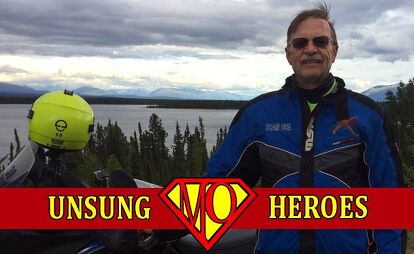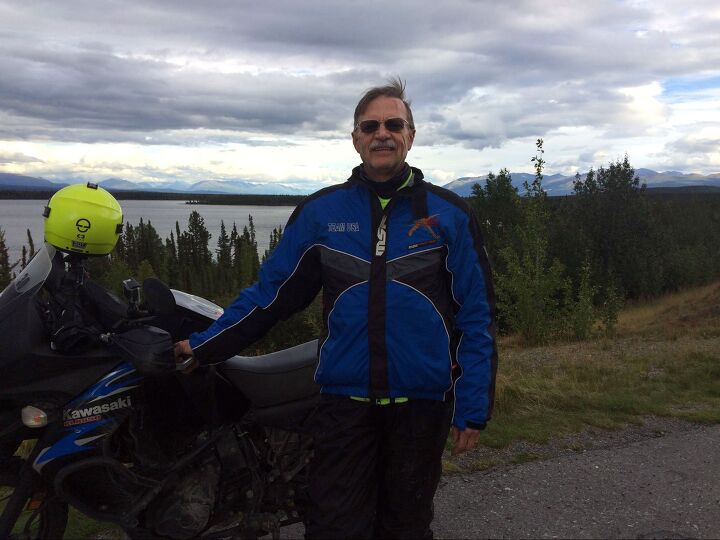Unsung Motorcycle Heroes 4: Dave Thom
It’s fair to say that those who work in the motorcycle industry do so out of their love for bikes and our two-wheeled sport/hobby. It doesn’t really matter if you’re a PR agent, a journalist or a factory representative, a person could earn more money if their job was instead in the automotive field. Meanwhile, there are thousands of moto-loving people who work tirelessly behind the scenes to promote and help enhance the world of motorcycling, routinely without any fanfare whatsoever.
That’s why we’ve decided to shine a little light on some of the people who have devoted significant portions of their lives to nurturing and advancing how we use and enjoy motorcycles in a multi-part series about those who help develop motorcycling and boost its exposure. —Kevin Duke, Editor-in-Chief
If you’ve been consuming motorcycle literature for more than a few years, chances are you’ve heard of Dave Thom, but if you care about the safety of your noggin, maybe not as much as you should. Mr. Thom started his motorcycle safety career in 1977 at the University of Southern California working on the “Motorcycle Accident Cause Factors and Identification of Countermeasures,” better known in the moto community as the “ Hurt Report” after the late Professor Harry Hurt.
Nearly 30 years later, that study of 900 motorcycle accidents in the Los Angeles area remains the largest and most comprehensive study of motorcycle accidents ever done in the United States. Among other things, the report concluded “the use of the safety helmet is the single critical factor in the prevention or reduction of head injury,” and confirmed the protective benefits of DOT-certified helmets. It also refuted the anti-helmet propaganda that lingers on, that helmets could limit vision and hearing and break necks. (A complete list of the report’s findings is here.)
Since that time, Thom has appeared on television, radio and in national magazines as an expert in helmets used for motorsports, snowsports and bicycles, and has testified before the California State Assembly as well as the National Transportation Safety Board about helmet effectiveness. By 1998, Thom had become General Manager of the Head Protection Research Lab at USC, where he tested thousands of helmets, and since 2003 he’s been working as a Senior Forensic Consultant, “providing helmet design, accident performance consultation and head injury analysis to individuals, manufacturers, attorneys and agencies for Cities, Counties and States.” Basically if you run into trouble selling beanies with fake DOT stickers, Mr. Thom is the one guy you don’t want to see on the other side of the courtroom.
One of the things that made the Hurt Report so important was that it was conducted by people who were all motorcyclists themselves, and so knew what they were looking at and why it mattered. According to Prof. Hurt’s AMA Hall of Fame profile, he “and colleagues David Thom and James Ouellet, put together a team of investigators who would dash out to motorcycle accident scenes, day or night, over two years. Crucially, all of the investigators were experienced motorcyclists. The team did an exhausting study of each crash, determining approximately 1,000 data elements. They took photos, examined wreckage, measured skid marks, and interviewed survivors. They even returned to the same site at the same time on the same day of the week, with the same weather conditions, to measure traffic and interview motorcyclists who managed to get through the same situation without having a problem. The team collected data on more than 900 motorcycle accidents, interviewed 2,310 passing motorcyclists, and studied 3,600 police reports from the same area.”
Born in Boston, Massachusetts, in 1955, Mr. Thom moved to SoCal in 1965, just in time for the greatest motorcycle boom of all time, and has been riding motorcycles (and bicycles) on- and off-road ever since. In fact, the Prof. Hurt relationship began as a result of Thom working in an L.A. motorcycle shop where Hurt bought parts. Since then, in addition to MotoVentures training, he’s found time for the California Superbike School and the Skip Barber High Performance Driving School, ATV training, the MSF’s Experienced Rider Course at least four times and its Dirt Bike School.
Obviously, then, he’s a believer in rider training. What advice does he have for today’s motorcyclist to stay safe?
“Training and frequent practice of skills are critical, also being conspicuous – and of course cover all of your head that you want to keep with a good helmet,” says Thom.
When we asked if helmet technology is still evolving, Mr. T had this to say:
“There are definitely new technologies emerging that will improve helmets and head protection. Dr. Terry Smith worked with Professor Hurt and I at USC and recently presented a paper at an international meeting. All of the “anti-rotation” technologies reduced rotational acceleration on the particular test Terry used. The problem is that there isn’t a standardized test yet and there are no accepted pass/fail criteria, so it’s all somewhat experimental at this point. With that said, I wore my new 6D ATS-1 to work today.”
In 1967, a federal law required states to pass universal helmet laws in order to receive funds for certain federal safety programs and highway construction, and by the early 1970s, almost all the states complied. By 1976, a successful lobbying effort got Congress to stop the Department of Transportation from assessing financial penalties on states without helmet laws, and many state laws were repealed or amended – roughly in the time frame the Hurt Report was being conducted. Today, only 19 states and DC have universal helmet laws, partial laws apply in 28 states (usually to riders 17 and younger), and Illinois, Iowa and New Hampshire have no helmet laws.
What does Mr. Thom, as an AMA Charter Life Member, think about the AMA and current helmet laws?
“I’m certainly not happy that AMA aligns with the other Motorcyclist Rights Organizations fighting helmet laws. They support voluntary helmet use, but at least they don’t spout any of the anti-helmet crap others do: helmets break necks, block vision, hearing, etc. I’m not a member of any other MRO and never will be, and have let AMA know that I think we’re shooting ourselves in the foot by fighting an obvious safety intervention. With the wholesale repeal of helmet laws nationwide, I am a supporter of leaving the DOT coverage requirements alone so riders can buy a partial coverage (shorty, half) helmet that provides a reasonable level of protection to what it covers. Personally, I like all my head and won’t wear one, but I certainly respect that as an option to those who might go bare-headed. I’m on the AMA magazine cover this month for my 15-minute shot at fame; with that and a couple bucks I can get coffee at Starbucks!”
Thank you, Mr. T, for doing your best to keep our gray matter gray, and telling it like it is.
Related Reading:
Unsung Motorcycle Heroes 1: Steve McLaughlin
Unsung Motorcycle Heroes 2: Bob Starr
Unsung Motorcycle Heroes 3: Paul Pepe of Ride Lake Superior
Unsung Motorcycle Heroes 5: Laura Klock
More by John Burns



































Comments
Join the conversation
I've broken two helmets on the road. Some would say those helmets did the world an injustice. But I thank folks like Dave very much.